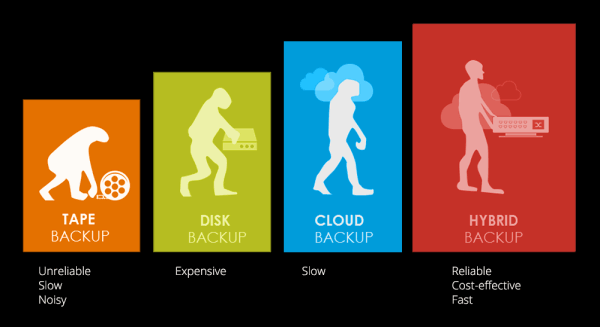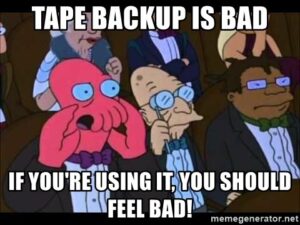4QuartersIT: Blog

Backup Methods are NOT Created Equal
As everyone knows, March 31st is National Backup Day (just kidding, there are only like 8 people who know this). In honor of National Backup Day, 4QuartersIT will be focusing our blog posts on common topics surrounding data backup. This week’s post will discuss the various types of backup methods that are available, and give some “good/bad/ugly” of each backup type. First, let’s start with the basics…
What is a backup? A backup is generally defined as a “second copy of a file or other type of digital data”. As you will see, this is an oversimplification of the concept, but for the purposes of laying a foundation this definition will be good enough.
Why do I need to back-up my data? Anyone who has ever lost important digital data knows the value of having a backup. Hard disks fail (we have boxes full of failed drives destined for the crusher), files can be deleted (accidentally or intentionally), and viruses can damage or encrypt data beyond repair. These are just a few of the reasons that having a backup is critical for anyone who stores digital data. Which is to say, pretty much everyone.
OK. So I need to back-up my data, what kind of backup do I need? With so many different methods for backing up important data available, choosing the right backup method for your needs can be overwhelming. Never fear, we’ve done the hard part! All you need to do is read. Below is a list of common backup methods and a few pros and cons of each.

Disk to Disk Backup – Disk to disk backup is the next step in the evolution away from tape backup systems. Disk based backup systems range from a portable USB storage device that you copy your files to each day, to a multi-terabyte Storage Area Network (SAN) designed to hold millions and millions of files. Smaller disk to disk systems using a portable USB storage device are like tape in that they should be taken offsite to avoid potential damage during a fire, flood or similar disaster. As with tape, this exposes the organization to risk if the USB device were to be lost or stolen. The obvious downside to a giant SAN based disk-to-disk backup system is that the system is not designed to be moved. The copy of the data on the SAN will be destroyed along with the primary data in the event of a significant disaster.
Cloud Backup – Because it solves the “offsite” challenges presented by the above backup methods, the Cloud Backup method is rapidly becoming the backup method of choice. In a nutshell, Cloud Backup solutions make a copy of important data, and sends that data to a storage system located “in the Cloud” (not a real cloud, though that would be cool). While this does eliminate the need to have someone physically take a tape or USB disk offsite at night, Cloud Backup is not without its challenges. Because the backup uses your internet connection to transmit data, available bandwidth can limit how much data can be transmitted during a backup. Conversely, if a data loss event occurs requiring a full system recovery, your recovery time is dictated by the speed of your internet connection. This can be a severe drawback to traditional cloud backup.

- Data backups require very little, if any, human intervention once set up (no taking devices offsite).
- Data is stored in a geographically distant location for maximum safety
- By using a Cloud Backup solution with built in Disk-to-Disk capability, we can recover large amounts of data without being limited by internet bandwidth.
Our clients enjoy the peace of mind that comes from knowing that their data is not only backed up, but is easily recoverable. Having a backup is only useful if it can be recovered! For more information on our award winning Cloud Backup with Rapid Recovery Solution, please email us at info@4quartersIT.com and we’ll be happy to provide a demo!
A word about “Cloud Storage” – Services like Dropbox and Microsoft’s OneDrive, known commonly as “Cloud Storage” are often confused with Cloud Backup. These services provide a cloud based location to synchronize your files to. It is important to keep in mind that this synchronization occurs regardless of the status of the file. For example, if someone in your organization inadvertently opens a Crypto-locker style virus and encrypts thousands of documents, those encrypted documents will now be synchronized to Dropbox. If not configured correctly, you may have no additional copy of these files as now your primary AND backup copy are damaged. These file-sync services are useful for many reasons, but they should never be treated as a true backup solution.






